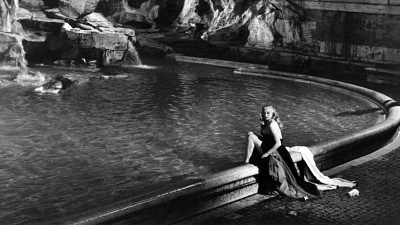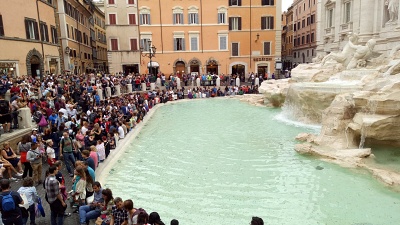Roman holiday
I’m too serious to be an amateur, but not enough to be a professional.
No, that’s not a sudden unguarded bit of self-reflection coming from me (although, come to think of it, I suppose it could be). That’s a quote from one of world cinema’s classics. It’s a self-assessment from an ill-fated intellectual friend of Marcello Rubini, the free-living free-loving tabloid journalist played by Marcello Mastroianni in Federico Fellini’s 1962 touchstone La Dolce vita.
That movie had a lot of great lines, including this one delivered by Anita Ekberg in the role of the Swedish bombshell actor Sylvia. Asked by a reporter whether she slept in pajamas or in a nightgown, she replied provocatively, “Neither. I sleep only in two drops of French perfume.”
Or how about when a smitten Marcello gushes to Sylvia, “You are everything… everything! You are the first woman on the first day of creation. You are mother, sister, lover, friend, angel, devil, earth, home”?
If there is an enduring image from that movie which has burned itself into the pop culture consciousness more than any other, it has to be the scene where Sylvia impulsively lures Marcello for a dip in Rome’s elaborately sculpted Trevi Fountain. It’s the sort of collective memory that tends to make a film buff feel like a mere part of the hive mind.
 How things are in the movies
How things are in the movies
It’s also the sort of cinematic experience that makes a visit to the actual location where it was filmed feel like an obligatory pilgrimage. Somehow I had never been to Rome until last month. I had certainly been to Italy numerous times before, beginning with student travels to Florence and Genoa. Since living in our Gaelic island corner of Europe, we have holidayed in places like Tuscany, Sorrento, the Amalfi Coast, Venice and others, but we somehow had never made it to the capital. And it wasn’t because of a lack of interest or motivation. The Missus, a good Roman Catholic (well, as good as most in Ireland these days), had been on about going there for ages. So off we finally went.
In all honesty, we didn’t actually spend all that much time in Rome, and about half of that was spent in the Vatican, which is technically not even part of Italy. For whatever reason, our visits to continental Europe—especially Italy—have in recent years taken on the character of religious tours. I suppose it is inevitable that any visit to Europe that focuses on history is going to involve a lot of churches, basilicas, cathedrals and other religious sites. This particular tour, for example, included time in the respective basilicas of saints Francis and Clare (documented most photogenically by Franco Zeffirelli in Brother Sun, Sister Moon), where their earthly remains are entombed, in Assisi; the monastery founded by Saint Benedict in 529 on the stunning mountain Monte Cassino; and the Santa Maria Assunta Cathedral in the medieval Umbrian city of Spoleto where the internationally renowned theater, music, ballet and arts event known as the Festival dei Due Mondi (Festival of Two Worlds) is held each year. And that was before we even got to the Sistine Chapel and St. Peter’s Basilica in Vatican City.
But enough about religious stuff. What about the cinematic pilgrimage I mentioned? The problem with Rome is that there is too much. It’s like pondering a film pilgrimage to Hollywood. It’s like thinking you might go to the Vatican Museum for an hour or two because they might have a few interesting statues or paintings there. (Me explaining the joke: if you were to spend a minute looking at each painting there, it would take four years. The rooms containing the art extend 4½ miles.)
Rome is Europe’s film capital. It is the location of Cinecittà Studios, located on 99 acres and the largest film and television production facility on the continent. The list of movies made there since its founding in 1937 is quite a long one.
Probably no filmmaker is more identified with the city than Fellini, although one shouldn’t overlook names like Rossellini, Visconti, Leone, Bertolucci or even Yanks like Coppola, Scorsese and Mel Gibson, who filmed The Passion of the Christ there as well as on location in Matera in southern Italy. And that’s just the tip of the iceberg.
The movie that did the most to put Rome on the 20th-century cinematic map—and on itineraries of post-war American tourists—was no doubt William Wyler’s 1953 modern fairy tale Roman Holiday, which made Audrey Hepburn an international star. Many other Hollywood productions followed.
Perhaps the most haunting cinematic echo I encountered was a road sign spotted while traveling to and from Leonardo da Vinci Airport. It was for the coastal resort town of Ostia. It was there that the filmmaker Pier Paolo Pasolini was murdered in an incredibly savage manner in 1975. A 17-year-old man confessed to the crime and served prison time, but the circumstances of the killing, which clearly involved others, have never been fully explained—making the terrible incident a fertile conspiracy theory breeding ground. Pasolini’s life was portrayed in Abel Ferrara’s Pasolini starring Willem Dafoe, while his death has been analyzed in movies like Marco Tullio Giordana’s Who Killed Pasolini? and Julian Cole’s Ostia.
So how did my long-awaited pilgrimage to the Trevi Fountain go? Did the waters magically part to allow me to join the ghost of Anita Ekberg under the gaze of the Titan Oceanus atop his chariot pulled by seahorses? Maybe it wouldn’t be too crowded, I hoped. After all, it was late October. How many tourists could there be? On the other hand, it was a Sunday. Anyway, I had already had my dip that morning, courtesy of a downpour that somehow emerged from completely bright, sunny skies.
 How things are in real life
How things are in real life
The area around the fountain was crammed to capacity. Every inch of space was filled by tourists, mostly young, mostly with their backs to the fountain, phones in hand, angling for the perfect selfie. Good luck with that. If Ekberg had been there in the flesh, you could never have spotted her in the crowd. Maybe that’s why the scene in the movie took place after midnight.
When Fellini coined the now-common term for aggressive photojournalists in La Dolce vita, could he have possibly foreseen that technology would eventually make each and every one of us a paparazzo?
It was time to escape the crowd and find a place a little less chockablock. We fled and then took a seat at an outdoor café on a nice piazza. That’s when we did what we had really come to Rome for. We shared a capricciosa pizza and a bottle of Montepulciano.
The sweet life indeed!
-S.L., 12 November 2023
If you would like to respond to this commentary or to anything else on this web site, please send a message to feedback@scottsmovies.com. Messages sent to this address will be considered for publishing on the Feedback Page without attribution. (That means your name, email address or anything else that might identify you won’t be included.) Messages published will be at my discretion and subject to editing. But I promise not to leave something out just because it’s unflattering.
If you would like to send me a message but not have it considered for publishing, you can send it to scott@scottsmovies.com.














